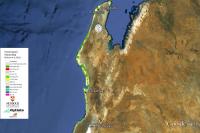Home > Biology and biodiversity > Coral reefs > Coral biodiversity > Ningaloo Hyvista remote sensing lagoonal habitat data
Ningaloo Hyvista remote sensing lagoonal habitat data
- Halina Kobryn
- Murdoch University

Using field-validated, image-derived spectra from a representative range of substrates, the habitat classification combined a semi-automated, pixel-based approach with fuzzy logic and derivative techniques. Five thematic classification levels for benthic cover (with probability maps) were generated, with the most detailed describing coral form in 46 classes. Macro-algae constituted most of the benthic cover, while hard and soft corals represented only about 7% of the total mapped area. Dense tabulate coral was the dominant coral mosaic type.
To make this product more accessible to managers, ecologists and other end-users the 3.5 GB data set was reduced to a 7 MB Google Earth KML file. This was achieved using the super-overlay hierarchical image tiling and compression method (https://developers.google.com/kml/documentation/kml_21tutorial#superoverlays). Super-overlays work by producing hierarchical sets of image tiles which have different image resolution. At a broad scale, only the low resolution tiles are viewed and, with increasing zooming, the corresponding higher resolution image tiles are automatically loaded into view.
Prior to generating the final KML file, the original image was resampled from a 3.5 m pixel to a 9 m pixel using a focal majority filter via the r.neighours function in the GRASS GIS software (version 6.3.1, GRASS GIS development team 2012). Thematic classes from the 46 in the original product were combined to create 12 general classes. KML super-overlays were generated using the open source Geospatial data abstraction utility (GDAL, www.gdal.org) software library “gdal2tiles”. The process involves three main steps namely, importing the image into gdal, projecting the image into geographic coordinates and finally generating the hierarchical image tiles using the gdal2tiles.py python script supplied with the gdal2tiles library (www.klokan.cz/projects/gdal2tiles). The resulting KML file can be easily viewed and interrogated using either Google Earth or Google Maps. The dataset can be used in the field as it is easily loaded onto portable GPS-enabled mobile devices such as smart phones and tablets.






